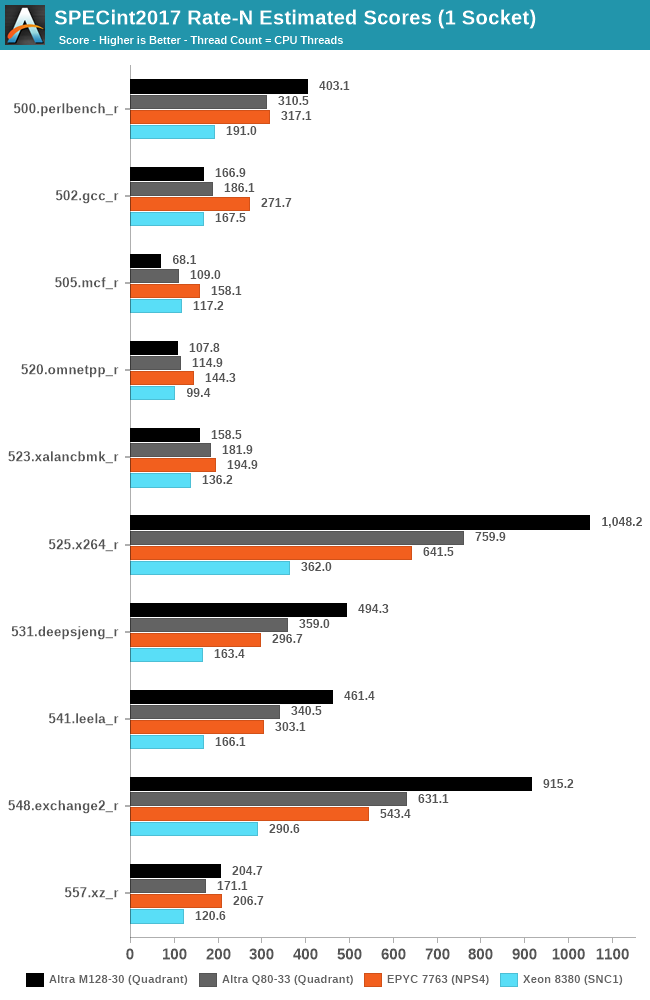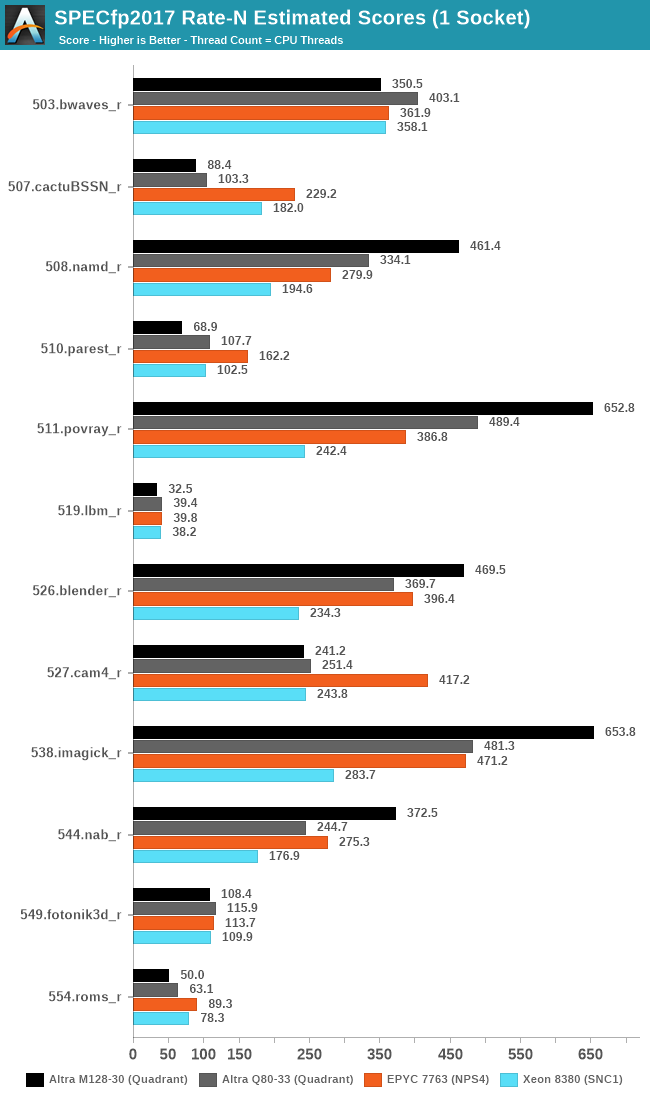The Ampere Altra Max Review: Pushing it to 128 Cores per Socket
by Andrei Frumusanu on October 7, 2021 8:00 AM EST- Posted in
- Servers
- Arm
- Neoverse N1
- Ampere
- Altra Max
SPEC - Multi-Threaded Performance - Subscores
We’re starting off with the multi-threaded/process SPEC CPU rate results. As usual, because there are not officially submitted scores to SPEC, we’re labelling the results as “estimates” as per the SPEC rules and license.
We compile the binaries with GCC 10.2 on their respective platforms, with simple -Ofast optimisation flags and relevant architecture and machine tuning flags (-march/-mtune=Neoverse-n1 ; -march/-mtune=skylake-avx512 ; -march/-mtune=znver2).
We’re focusing our comparisons between the new M128-30, the previous Q80-33, and AMD’s flagship EPYC 7763 and Intel’s new Xeon 8380. The Altra chips are running at 250W TDPs at respectively 128/80 cores, the EPYC at 280W and 64 cores, and the Xeon at 270W for 40 cores. The SMT systems have it enabled, and we’re running peak threads in these subscores.

In SPECint2017, we’re seeing two different result-sets for the new Altra Max system – either very large gains, or some more notable performance regressions.
Workloads such as 525.x264_r, 531.deepsjeng_r, 541.leela_r, and 548.exchange2_r, have one large commonality about them, and that is that they’re not very memory bandwidth hungry, and are able to keep most of their working sets within the caches. For the Altra Max, this means that it’s seeing performance increases from 38% to 45% - massive upgrades compared to the already impressive Q80-33.
The 45% increase in 548.exchange2_r is essentially almost perfect linear scaling with the core count and frequencies; although the M128-30 has 60% more cores, it’s also running at 10% lower frequencies, so 45% more theoretical throughput.
523.xlancbmk_r also isn’t very DRAM traffic heavy in traditional systems, however it has a larger working set than the other aforementioned workloads, and the smaller SLC size and increased core count don’t do it favours as it becomes resource contended. The same can be said of 502.gcc_r, which is also slower than the Q80-33.
505.mcf_r is the worst-case scenario, although memory latency sensitive, it also has somewhat higher bandwidth that can saturate a system at higher instance count, and adding cores here, due to the bandwidth curve of the system, has a negative impact on performance as the memory subsystem becomes more and more inefficient. The same workload with only 32 or 64 instances scores 83.71 or 101.82 respectively, much higher than what we’re seeing with 128 cores.

In the FP suite, we’re seeing a same differentiation between the M128-80 and the other systems. In anything that is more stressful on the memory subsystem, the new Mystique chip doesn’t do well at all, and most times regresses over the Q80-33.
In anything that’s simply execution bound, throwing in more execution power at the problem through more cores of course sees massive improvements. In many of these cases, the M128-30 can now claim a rather commanding lead over the competition Milan chip, and leaving even Intel’s new Ice Lake-SP in the dust due to the sheer core count and efficiency advantage.










60 Comments
View All Comments
lemurbutton - Thursday, October 7, 2021 - link
Before AMD can disrupt Intel in the server, Ampere has disrupted AMD. And now Intel is coming back with Saphire Rapids. Doesn't look good for AMD.Teckk - Thursday, October 7, 2021 - link
AMD also has upcoming products, same as other companies :) Competition is good.schujj07 - Thursday, October 7, 2021 - link
Most likely Sapphire Rapids will only get Intel to Epyc Milan or a little past there. Overall ICL Xeon only caught Intel up to Epyc Rome. Initial tests on Milan were good, showing 5-7% better performance which isn't bad, however, it wasn't like what we saw on the desktop side. Turns out the benchmarks were run on a reference platform that AMD hacked to allow 3rd Gen support. Once benchmarks were done on Milan on platforms designed for 3rd Gen the performance jumped by another 10% or more. Basically that put ICL 15-17% behind Epyc Milan and SPR is only supposed to get about 19% more performance.mode_13h - Thursday, October 7, 2021 - link
> Initial tests on Milan were good, showing 5-7% better performance which isn't badInitial tests were flawed, due to non-production hardware/firmware. Check out their update:
https://www.anandtech.com/show/16778/amd-epyc-mila...
schujj07 - Thursday, October 7, 2021 - link
"Initial tests were flawed, due to non-production hardware/firmware."I basically said that in my initial comment.
"Turns out the benchmarks were run on a reference platform that AMD hacked to allow 3rd Gen support. Once benchmarks were done on Milan on platforms designed for 3rd Gen the performance jumped by another 10% or more. "
GreenReaper - Saturday, October 9, 2021 - link
Your initial comment was too long, he didn't read that far before hitting reply.whatthe123 - Thursday, October 7, 2021 - link
icelake is not great in general. it was an improvement over 14nm but the core scaling was not there and their 10nm was still struggling to hit competitive boost clocks. I don't think the uplift they saw between 14nm and icelake reflects sapphire rapids at all considering the major design changes and improved node, but if it does I don't see how sapphire rapids would compete with milan at a lower core count. If its competing with milan then the per-core performance and MT scaling has seen a huge uplift compared to icelake.schujj07 - Thursday, October 7, 2021 - link
Had ICL come out on time people would have been more impressed. The problem that ICL has is since it was soooooo late Intel had to squeeze every ounce of performance out of SKL. Overall ICL is just a short term platform but the performance comparison to SPR.mode_13h - Friday, October 8, 2021 - link
> Had ICL come out on time people would have been more impressed.Depends on what you mean by "on time". If it had come in place of Cascade Lake, then probably. However, if it still followed Cascade Lake, then the clockspeed drop and strong competition from Rome & comparison with Graviton 2 are still unflattering.
If Ice Lake had notched up the clockspeed ladder *and* launched in place of Cascade Lake, then it would've been a very solid entry.
Anyway, I'm sure Intel is still selling every one they can make. People are quick to point out how AMD benefited from Intel's process woes, but the past 5 years' demand surge has provided Intel a very nice cushion. They basically couldn't have picked a better time to falter.
schujj07 - Friday, October 8, 2021 - link
I believe that ICL was supposed to be 2nd Gen Scalable. When Intel found that it wasn't ready, they released Cascade Lake. Even worse was needing to release Cooper Lake for 4-8S systems in 2H 2020.